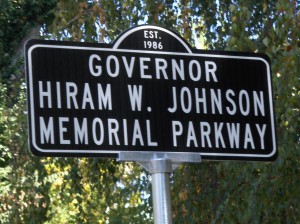Something Old That’s New in Capitol Park
 There’s something old that’s new in Capitol Park.
There’s something old that’s new in Capitol Park.
Walk out the rear doors of California’s Capitol and head toward the pathway that runs straight through the park to 15th Street. On the left, just before the trout pond, is a sign — a replica of the sorts of signs that stood on the corners of Sacramento streets in around 1910.
The sign says:“Hiram W. Johnson Memorial Parkway. Est. 1986.”
Twenty-two years ago a group of state Senate staffers and students of California history – Fred Silva, Senate President Pro Tempore David Roberti’s budget guru; Steve Larsen, chief consultant of the Budget and Fiscal Review Committee and Pete Detwiler, consultant to the Local Government Committee – realized it was the 75th anniversary of Hiram Johnson’s first year as governor.
And what a first year it was. Among other things, lawmakers worked with Johnson to create the ballot initiative process, give California women the right to vote, provide for the direct election of California’s United States senators, reform water law, improve flood control, make kindergarten mandatory, give women a minimum wage, enact more humane child labor laws and regulate utilities through the Public Utilities Commission.
“When the people want change and there’s a governor who is willing to lead, you do get results,” said Detwiler, who has had a copy of the resolution memorializing Johnson’s first year as governor on his office wall for 22 years. “We’re policy midgets by comparison.”
Interestingly, Johnson’s estranged father, Grove, was a Sacramento Assemblyman up until December 1910 when he resigned – one month after his son was elected governor.
Grove Johnson was the chief advocate of the railroad machine his son pledged to derail in his campaign. (Editor’s Note: Paging Dr. Freud, Dr. Sigmund Freud.)
The Senate staffers convinced then Sen. Barry Keene to carry a resolution that would commend Johnson and name the pathway that goes from the back of the Capitol straight through to1 5th St. after the 23rd governor of California.
Senate Concurrent Resolution 77 was easily passed. It’s advocates framed two copies of the resolution. One is on Detwiler’s wall. The other was presented to Hiram Johnson III on September 2, 1986, the date of his grandfather the governor’s birthday.
The marching band of Sacramento High, Johnson’s alma mater, graced the affair, as did the color guard from Hiram Johnson High School.
“There were more people in the band than on the steps of the Capitol watching,” recalls Detwiler.
After the resolution passed Detwiler said he got some initial cost estimates on signs commemorating Johnson that were too expensive for his pocketbook and he dropped the project – for more than two decades.
“I was busy. Things came up. I never got around to it.”
In the interim, Silva and Larsen left the Legislature.
Last year, the pathway was being torn up and improvements were being made to it. Detwiler thought: “Well, as long as they’re tearing it up….”
Inquiries were made of the City of Sacramento’s sign shop as to what sorts of signs the city used around 1910. What would it cost to make two for the memorial parkway?
“It was $188,” Detwiler said. “I paid for it myself.”
With a champagne toast, Detwiler and Keene — now retired and living in East Sacramento – dedicated the signs last Friday.
-30-
Filed under: California History
- Capitol Cliches (16)
- Conversational Currency (3)
- Great Moments in Capitol History (4)
- News (1,288)
- Budget and Economy (383)
- California History (139)
- Demographics (11)
- Fundraising (74)
- Governor (122)
- Legislature/Legislation (270)
- Politics (173)
- State Agencies (38)
- Opinionation (36)
- Overheard (246)
- Today's Latin Lesson (45)
- Restaurant Raconteur (21)
- Spotlight (110)
- Trip to Tokyo (8)
- Venting (184)
- Warren Buffett (43)
- Welcome (1)
- Words That Aren't Heard in Committee Enough (11)

I always knew Detwiler was a class act! Especially when he gave me a pair of plastic pink flamingos to grace my lawn, in hopes it would annoy the homeowners association and their CC&Rs, interests on whose behalf I used to lobby the Senate Housing & Local Government Committee. Persistence and grace, with a healthy dollop of humor–that’s Peter. The Capitol’s collective community owes him a debt of gratitude for his tireless public service.
Comment by Robyn Boyer — 10.24.2008 @ 7:24 pm